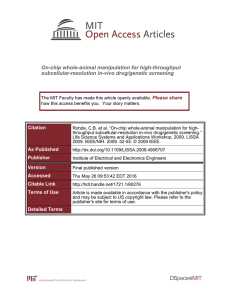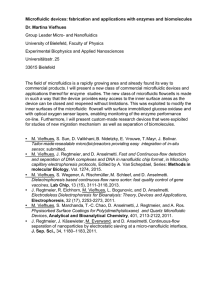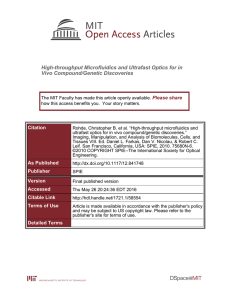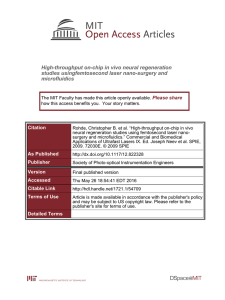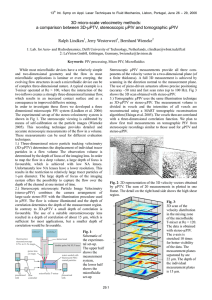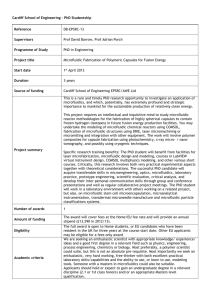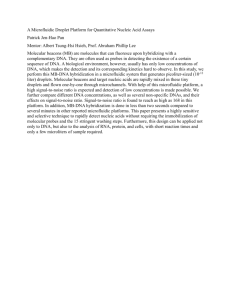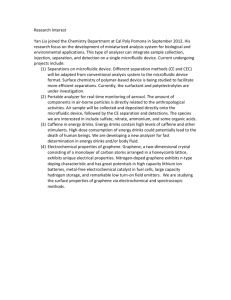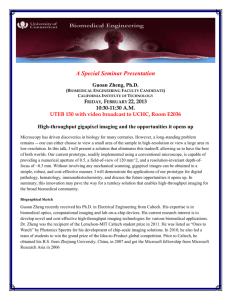On-chip sub-cellular resolution whole-animal manipulation for high-throughput in vivo screening Please share
advertisement
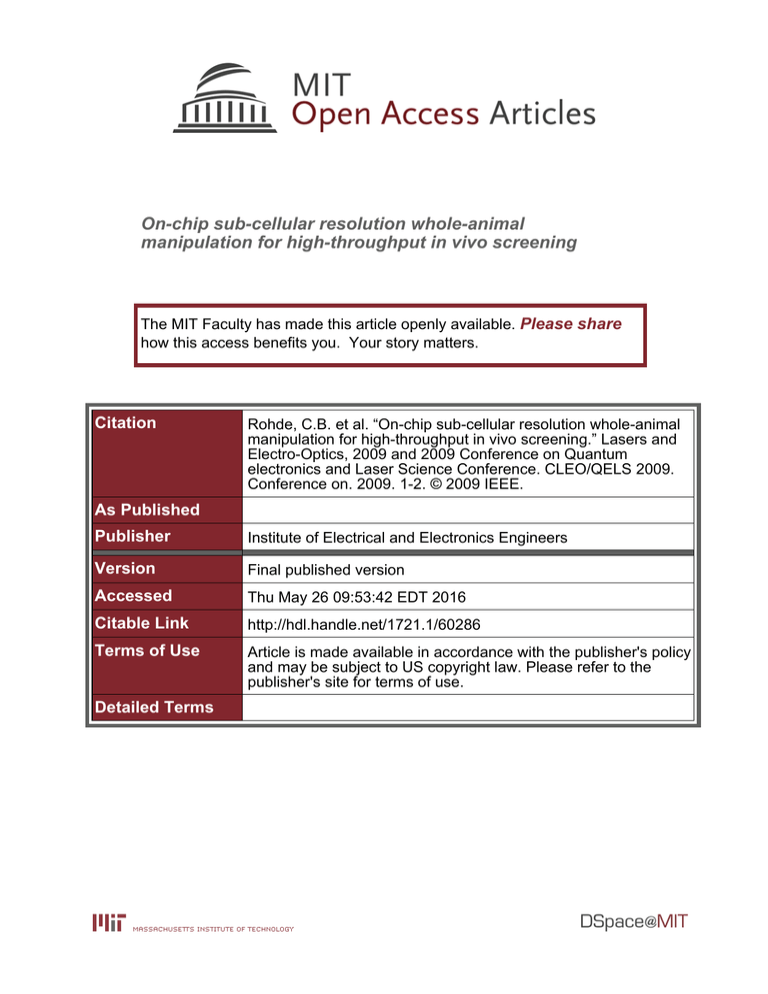
On-chip sub-cellular resolution whole-animal manipulation for high-throughput in vivo screening The MIT Faculty has made this article openly available. Please share how this access benefits you. Your story matters. Citation Rohde, C.B. et al. “On-chip sub-cellular resolution whole-animal manipulation for high-throughput in vivo screening.” Lasers and Electro-Optics, 2009 and 2009 Conference on Quantum electronics and Laser Science Conference. CLEO/QELS 2009. Conference on. 2009. 1-2. © 2009 IEEE. As Published Publisher Institute of Electrical and Electronics Engineers Version Final published version Accessed Thu May 26 09:53:42 EDT 2016 Citable Link http://hdl.handle.net/1721.1/60286 Terms of Use Article is made available in accordance with the publisher's policy and may be subject to US copyright law. Please refer to the publisher's site for terms of use. Detailed Terms © 2009 OSA/CLEO/IQEC 2009 a1253_1.pdf CMMM4.pdf CMNN4.pdf CMNN4.pdf On-chip Sub-cellular Resolution Whole-animal Manipulation for High-throughput In Vivo Screening Christopher B Rohde, Fei Zeng, Cody Gilleland, Chrysanthi Samara and Mehmet F Yanik Department of Electrical Engineering and Computer Science, Massachusetts Institute of Technology, Cambridge, MA, USA yanik@mit.edu Abstract: We present a suite of technologies that can be combined to perform complex highthroughput whole-animal genetic and drug screens. When used in various combinations, these devices facilitate a variety of high-throughput assays using whole animals. ¤2009 Optical Society of America OCIS codes: (170.0170) Medical optics and biotechnology 1. Introduction Small animal models have become increasingly important for biological discovery, and studies involving the nematode Caenorhabditis elegans (C. elegans medicine or chemistry over the last six years. C. elegans has emerged as a powerful model organism due to the availability of a wide array of species- its short development time and ability to grow in minute volumes. Additionally, C. elegans is optically transparent, which allows the use of powerful optical techniques that enable precise cellular and subcellular visualization within the living animal. Conventionally, researchers manipulate C. elegans manually and use anesthetic to immobilize animals for highresolution imaging, however, this is too slow and error prone for high-throughput studies. We previously -throughput, on-chip small-animal screening devices enabling assays at cellular resolution [1]. We have since developed techniques that improve these devices by allowing them to immobilize physiologically active animals with very high stability without using either chemical anesthetics or cooling [2]. These devices consist of multiple thin layers of poly(dimethyl siloxane) (PDMS) fabricated by soft lithography. We report here on three devices that, in various configurations, have the potential to significantly accelerate current genetic and drug screens and also enable completely new types of whole-animal assays: A microfluidic small-animal sorter, a multiplexed incubation-chamber chip for performing large-scale time-lapse assays, and a microfluidic interface chip for delivery of compound libraries. When used in various combinations, these devices facilitate a variety of highthroughput assays using whole animals, including forward and reverse genetic and drug screens at subcellular resolution and large-scale studies of neural degeneration and regeneration using femtosecond laser nanosurgery. 2. Microfluidic small-animal sorter The -animal sorters we have developed can rapidly isolate and immobilize individual animals using microfluidic valves to direct the flow of animals through microfluidic channels. Fig. 1 shows the isolation, immobilization and imaging of an animal. To improve immobilization stability, an immobilization layer is placed above the main chamber of the sorter. When the channel is pressurized, a membrane expands downwards, wrapping around the animal and holding it against the multiple aspiration ports (Fig. 1.iv). The stability achieved using this method is comparable to chemical anesthetics, and does not affect the lifespan or progeny production of the animal. 978-1-55752-869-8/09/$25.00 ©2009 IEEE © 2009 OSA/CLEO/IQEC 2009 a1253_1.pdf CMMM4.pdf CMNN4.pdf CMNN4.pdf Fig. 1. Small animal isolation (i-ii), immobilization (iii-iv) and imaging (v). High-magnification image shows close-up combination brightfield and fluorescent image of an immobilized animal illustrating gfp-labeled mechanosensory axons (scale bar i-iv: 250 μm, v: 20 μm). 3. Multiplexed incubation chambers and multiwell interterfacing To perform high-throughput time-lapse studies on small animals we have designed the microfluidic-chamber device shown in Fig. 2a for worm incubation and for continuous imaging at subcelluar resolution. Individual chambers can be addressed using microfluidic valves. The medium in the chambers can be exchanged through the microfluidic channels for complex screening strategies, and precisely timed exposures to biochemicals (e.g., drugs/RNAi) can be performed. An array of posts arranged in a semi-circular configuration permits exchange of media while keeping animals in the chamber. To simplify the delivery of existing large-scale RNAi and drug libraries, we have also ic interface device shown in Fig. 2b. This device large-scale multi-well-format libraries. Minute amounts of individual compounds from standard multi-well plates can thus be routed to other devices, and the connection lines can be automatically washed between samplings. Fig. 2. (a) Multiplexed microfluidic incubation chambers, illustrating media exchange and small-animal immobilization. (b) Microfluidic interface device for compound delivery. 4. Applications The rapid and repeatable immobilization provided by our microfluidic devices enables not only not only highthroughput screening of cellular and sub-cellular phenotypes in whole animals, but also enables the use of highprecision techniques such as femtosecond-laser nanosurgery and multiphoton microscopy on physiologically active animals. Fig. 3 shows images taken on-chip using two-photon imaging and femtosecond laser nano-surgery of the mechanosensory axons in a green fluorescent protein (gfp) labeled animal. We are currently using these devices to investigate the genetic and chemical mechanisms involved in neural regeneration. Fig. 3. On-chip sub-cellular imaging and manipulation (a) Two-photon imaging and (b) femtosecond nanosurgery 5. References [1] C.B. Rohde, F. Zeng, R. Gonzalez-!"# !"$"% &'!** -chip high-throughput whole-animal sorting +""#. Sci. U. S. A. 104, 13891413895 (2007). [2] $"6 ;"<" !"$"% &'=-cellular precision on-chip small-animal immobilization, multi-photon imaging and femtosecond +>; 8, 6534656 (2008).
